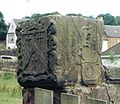Market cross


A market cross, or in Scots, a mercat cross, is a structure used to mark a market square in market towns, where historically the right to hold a regular market or fair was granted by the monarch, a bishop or a baron. Market crosses were originally from the distinctive tradition in Early Medieval Insular art of free-standing stone standing or high crosses, often elaborately carved, which goes back to the 7th century. Market crosses can be found in most market towns in Britain. British emigrants often installed such crosses in their new cities, and several can be found in Canada and Australia.
These structures range from carved stone spires, obelisks or crosses, common to small market towns such as that in Stalbridge, Dorset, to large, ornate covered structures, such as the Chichester Cross or Malmesbury Market Cross. Market Crosses can also be constructed from wood; an example is at Wymondham, Norfolk.
Towns and Villages in Great Britain with a Market Cross
A
B
C
D
E
F
G
H
}
K
L
M
N
O
P
R
S
W
See also
References
This article needs additional citations for verification. (July 2013) |









